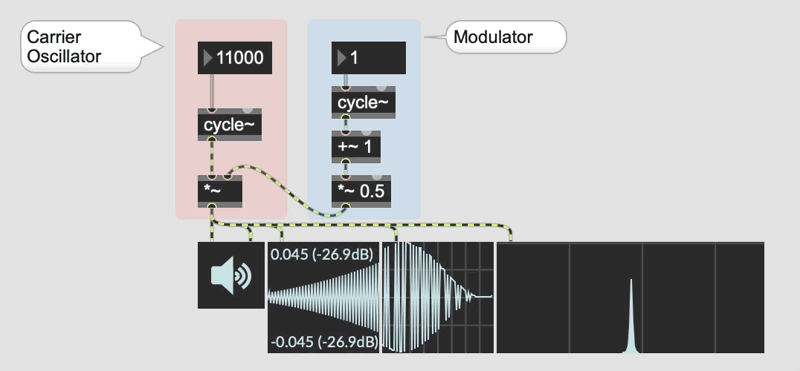Last time, we talked about waves. Waves have three features; Amplitude, frequency, and phase. Today, we'll modulate the wave's amplitude by another wave.
RM
RM, Ring Modulation, is the simplest way to modulate the amplitude of a wave. First, let's make a 220hz(A) sine wave.We modulated the amplitude by a 1hz sine wave. This is RM. And, we can say "The modulator modulated the carrier oscillator's amplitude".
What if we modulate the amplitude 100 times a second or more? Let's change the frequency to 11000 in easy to see.
We can get some partials and it is divided into two pitches. And it lost the fundamental. Then, what is AM, Amplitude Modulation, and what's the difference between the two of them?
AM
AM is almost the same as RM. But we have to do some mathematics before putting the wave into the amplitude. Because in digital, 1 is the maximum without clipping noise. 0.5 is a half and 0 is nothing. How about -1? -1 is reversed. I mean, the phase shift is 180 degrees. Let’s compare with a pulse wave.
So we can see the phase shift. Then, why is this happening? Let's see pulse wave modulated by very very low frequency.
Did you notice that? Sine wave's range is 1 to -1. If the amplitude goes down to 0, the phase is shifted by 180 degrees. Therefore, we know why RM produces two bounces even if we put the 1hz wave into the amplitude and the second one's phase is shifted by 180 degrees.
Let's make AM. We have to do some math to make that. First, add 1.
And multiply by 0.5.
This is the equation of AM.
\( \left( \text{wave} + 1\right) \times 0.5 \)
Now, we can make AM. If we put a 1hz sine wave, there is only one bounce, unlike RM.
So, we can say "The modulator modulated the carrier oscillator's amplitude".
And also, what if we modulate the amplitude 100 times a second or more? Let's change the frequency to 11000 in easy to see.
We can get some partials and it is divided into two pitches. But it still has a fundamental.
So, we can see the obvious differences between RM and AM.



















